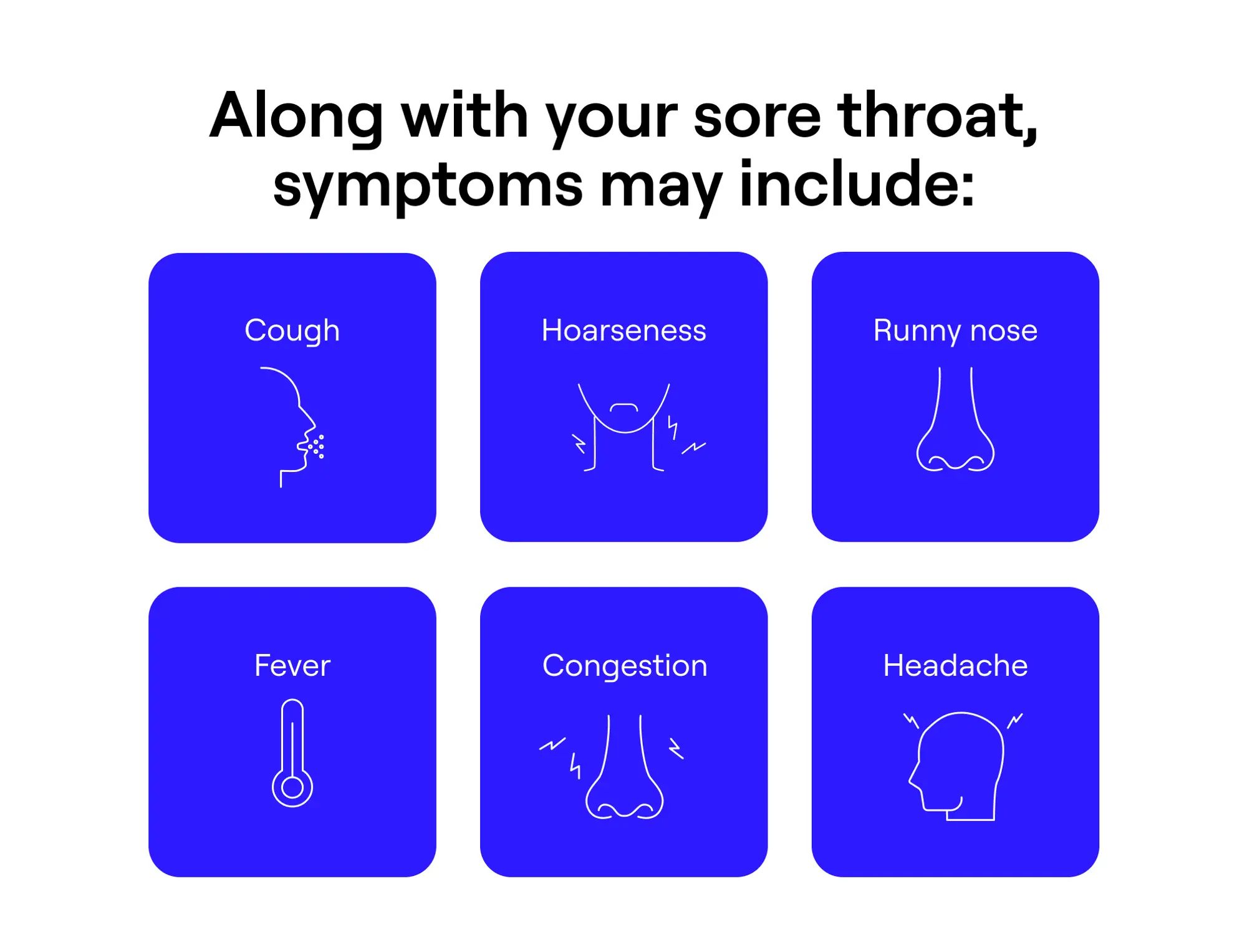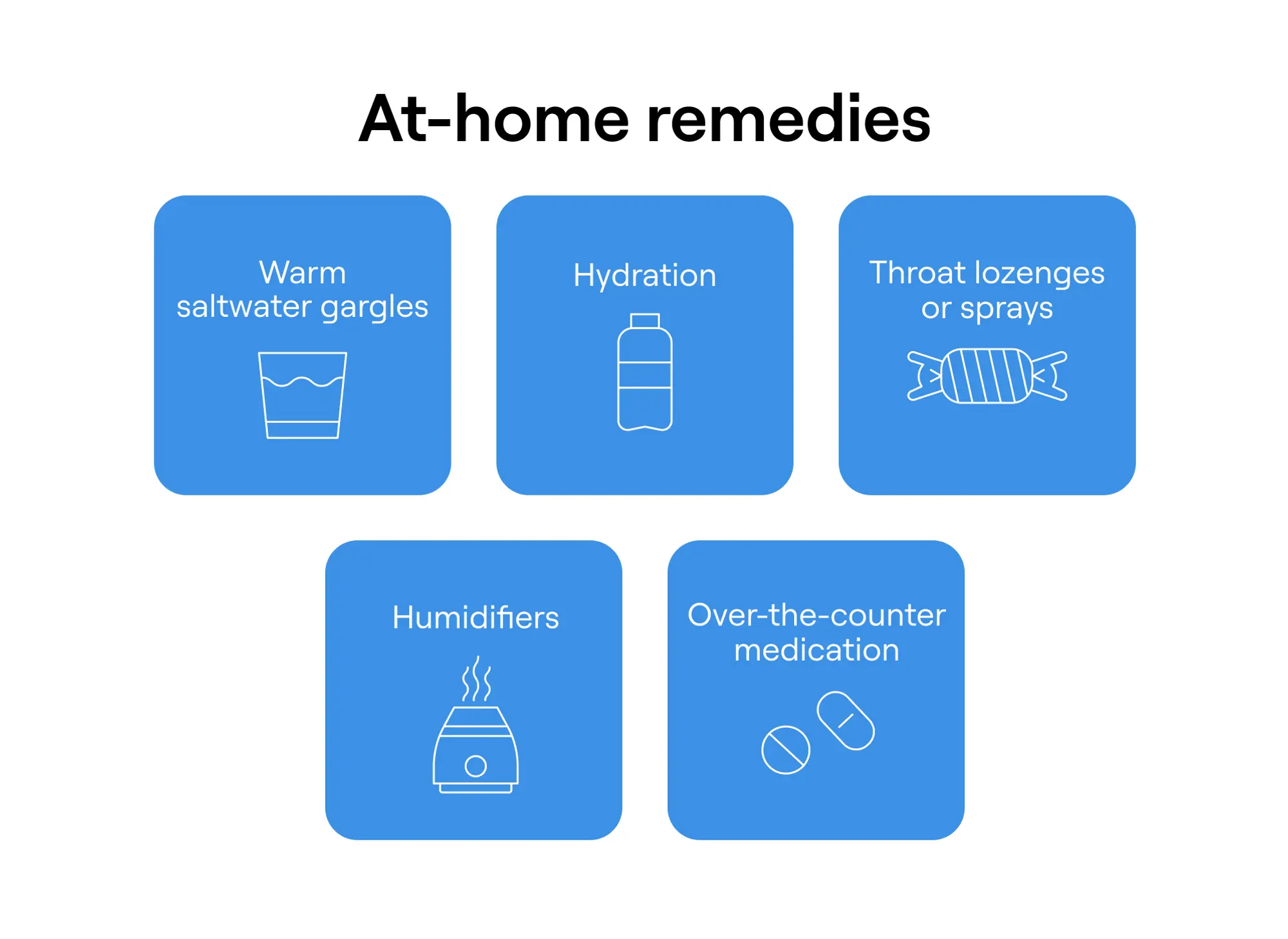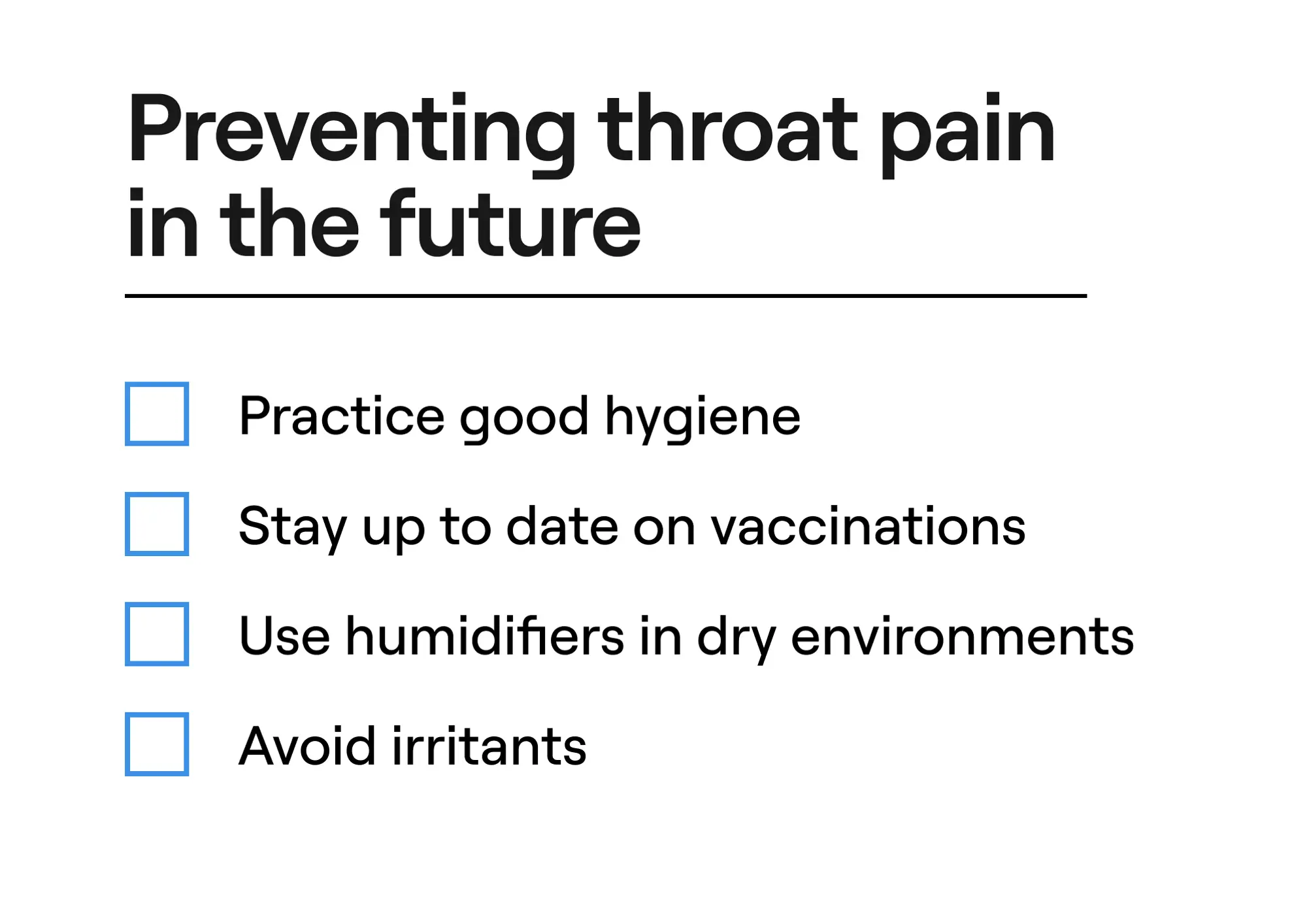
Jump to
Book a visit
$25 typical copay
$100 without insurance
Get expert care for your pain today.
When every swallow feels like sandpaper, it’s natural to wonder what’s causing it and how to make it stop. From everyday culprits like colds and allergies to bigger issues like strep or acid reflux, this guide breaks down what’s causing the pain, how to spot the difference, and when to get it checked out. The good news? You can get relief—and even prescriptions—without leaving home.
It starts as a tickle when you sip water or swallow food. Before long, you’re wincing every time your throat has to do its job. When throat pain shows up out of nowhere, you might wonder why your throat hurts when you swallow, how serious it might be, and what you can do to feel better fast.
The cause of throat pain isn’t always straightforward. It could be something simple, like a cold or allergies, or something that requires medical treatment, such as strep throat or a fungal infection. This guide will walk you through the most common reasons why it hurts to swallow, how to tell them apart, and what steps to take next.
Throat anatomy and function
Your throat is a shared pathway for food, liquids, and air, meaning it plays a key role in both digestion and breathing. Medically known as the pharynx, the throat connects your nose and mouth to your esophagus and windpipe, and it works hard behind the scenes every time you eat, drink, talk, or breathe.
Several structures make up the throat, including:
- Esophagus (your food pipe)
- Trachea (windpipe)
- Larynx (voice box)
- Oropharynx (the area containing your tonsils)
- Epiglottis (a flap that covers your windpipe when you swallow to keep food and drink out of your airway)
When any of these areas become irritated, swollen, or infected, it can cause pain in the throat when swallowing. Whether it’s inflamed tonsils, acid creeping up from the stomach, or allergies causing postnasal drip, understanding the location and nature of your throat pain can often point to the source.
Common causes of painful swallowing
If it hurts to swallow with your sore throat, one of several common culprits is likely to blame. Here’s a breakdown of the most frequent causes, including what they feel like, what to look for, and when to consider getting medical help.
Sore throat (pharyngitis)
A sore throat from a viral infection—like the common cold, flu, or even COVID—is one of the most common reasons swallowing becomes uncomfortable. Along with your sore throat, symptoms may include:
- Cough
- Hoarseness
- Runny nose
- Congestion
- Headache
- Fever
Most viral sore throats go away on their own within three to 10 days with rest, fluids, and over-the-counter pain relievers.

Symptoms of pharyngitis
Allergies
Allergic reactions can also lead to throat inflammation and painful swallowing. “Allergies can cause postnasal drip, which irritates the throat lining and leads to soreness,” says Adam Carewe, MD, a family medicine doctor at General Medicine. “In allergic rhinitis, allergens trigger histamine release, causing nasal congestion and increased mucus production. This mucus drains down the throat (postnasal drip), leading to inflammation and discomfort.”
This is especially common during allergy season or if you’re exposed to common allergens like dust, pollen, or pet dander. In most cases, over-the-counter allergy medications can help relieve symptoms.
Strep throat
Strep throat, or bacterial tonsillitis, is an infection caused by group A streptococcus bacteria. One telling sign of strep is that it comes on quickly and hits hard. In addition to severe throat pain and painful swallowing, common symptoms include:
- Red, swollen tonsils
- Tiny red spots on the back of the roof of your mouth
- Rash
- Fever
- Aches
- Headache
- Swollen lymph nodes in your neck
Another key way to distinguish strep throat from more common viral infections? Colds, flus, and COVID often cause coughing, but not strep. Unlike viral sore throats, strep requires antibiotics to stop the spread of infection and prevent complications. Visit a doctor to get a rapid strep test so you can start antibiotics as soon as possible if need be.
Tonsillitis
There are also viral forms of tonsillitis, an infection in your tonsils often caused by the common cold or flu. Typically, viral tonsillitis is milder than bacterial tonsillitis (strep throat), but it can still cause symptoms like:
- Pain or difficulty swallowing
- Scratchy throat
- Red, swollen tonsils
- White spots or coating on your tonsils
- Fever
- Swollen lymph nodes
Unlike bacterial tonsillitis, which requires antibiotics, viral tonsillitis usually resolves itself in three to four days as long as you’re staying well hydrated and getting enough rest.
Gastroesophageal reflux disease (GERD)
GERD, also called acid reflux, is a condition where your stomach acid flows backward into your esophagus. One telltale sign of acid reflux is a burning or sour sensation in the throat. Other symptoms include:
- Backwash of food or liquid into the throat
- Difficulty swallowing
- A feeling of a lump in the throat
- Heartburn
- Upper belly or chest pain
- Cough
- Laryngitis
GERD-related pain tends to come and go depending on your lifestyle. For instance, smoking, drinking caffeine, eating big meals before bed, and eating fatty or fried foods can trigger symptoms. People with obesity, hiatal hernias, connective tissue disorders, and those who are pregnant are also at higher risk for the condition.
Throat irritation or injury
Sometimes the cause of your throat pain while swallowing isn’t an infection at all. “Dry air, pollution, smoke, or strong odors can irritate the throat lining and cause soreness,” says Carewe. “Low humidity dries out mucous membranes, while pollutants or irritants can inflame tissues in the throat and upper airways.”
Overusing your voice, smoking, and drinking hot beverages can also irritate your throat. Usually, throat pain will subside after you rest your throat or remove yourself from irritating environments. However, over-the-counter pain relievers, throat lozenges, cold foods, and soothing liquids (such as tea or broth) can help alleviate some of the discomfort.
Less common but serious causes
Most sore throats and painful swallowing are caused by common, treatable conditions. But in some cases, throat pain may point to something more serious. All of these conditions are more rare, but it’s important to be aware of them, especially if your symptoms persist or don’t respond to typical treatments.
Esophagitis
Esophagitis is inflammation of the esophagus (the tube that carries food from your mouth to your stomach). It can be triggered by acid reflux, allergies, infections, autoimmune diseases, and even certain medications (like NSAIDs or antibiotics taken without enough water).
Symptoms may include:
- Sore throat
- Painful, difficult swallowing
- Heartburn
- Chest pain
- Acid reflux
- Vomiting
If your symptoms are chronic or worsening, esophagitis warrants a trip to your doctor—left untreated, the condition can lead to complications like ulcers or scarring of the esophagus.
Oral thrush (Candidiasis)
Thrush is a fungal infection caused by an overgrowth of Candida albicans, a type of yeast that naturally lives in your mouth and throat. While it's most common in people with weakened immune systems, it can also occur after antibiotic use, in people with diabetes, or those who use inhaled corticosteroids (like for asthma).
“Candida albicans overgrowth in the mouth and throat causes white patches, redness, and discomfort. When it extends into the pharynx or esophagus, pain can be more severe, especially when swallowing,” says Dr. Carewe. Other symptoms may include:
- Cottony feeling in your mouth
- Redness and soreness in your mouth
- Loss of taste
Thrush is typically treated with antifungal medication; however, additional medical support may be necessary if your immune system is weakened.
Tumors or growths
Though rare, tumors of the throat, tonsils, or esophagus can cause persistent pain, especially when swallowing. These may start subtly, with symptoms like:
- Throat discomfort that doesn’t improve
- Hoarseness
- Cough
- A feeling of a lump in the throat
- A lump or sore that doesn’t go away
- Unexplained weight loss
There are also some sexually transmitted throat infections that can occur and that may cause a sore throat. Some bacteria that can cause these symptoms are gonococcal or chlamydial organisms.
If throat pain lingers for more than two weeks without signs of infection, or if it’s accompanied by other warning signs like difficulty swallowing, bleeding, or voice changes, it’s important to see a healthcare provider. If the tumor is due to throat or esophageal cancer, early diagnosis makes a significant difference in outcomes.
Diagnosis
Diagnosing the cause of throat pain typically begins with a conversation about your symptoms and medical history. Your provider will want to know when the pain began, whether it’s constant or comes and goes, and if it's accompanied by other symptoms. These details can help narrow down whether the issue is viral, bacterial, allergic, or something else entirely.
In many cases, a visual exam of the throat—either in person or via telehealth—can also provide valuable clues. If you’re showing signs of a bacterial infection (like strep throat), your provider may recommend a rapid strep test or throat culture to get a specific diagnosis. If your symptoms point to acid reflux, allergies, or something more complex, they may recommend further testing, such as bloodwork, imaging, or a referral to a specialist.
Treatment and relief options
How you treat a sore throat that hurts when you swallow depends on the cause. But in many cases, simple at-home remedies can go a long way in easing discomfort.
At-home remedies
For viral infections, allergies, or minor irritation, Carewe says that supportive care is often the first and best step; antibiotics do not shorten recovery for viral infections. Instead, he recommends:
- Warm saltwater gargles: Gargling with a saltwater solution helps reduce inflammation and loosen mucus.
- Hydration: Drinking plenty of fluids—especially warm ones like tea, broth, or warm water with honey—keeps the throat moist and soothes irritation.
- Throat lozenges or sprays: These can provide temporary pain relief by numbing the throat and reducing inflammation.
- Humidifiers: Adding moisture to dry indoor air can help prevent a dry throat, especially in winter or when sleeping with your mouth open.
- Over-the-counter medication: Pain relievers (like acetaminophen or ibuprofen) can help relieve pain and irritation from viral infections. Antihistamines (like Claritin or Zyrtec), decongestant medications (like Sudafed or Afrin), and nasal sprays (like Flonase and Nasacort) can all treat allergies.

At-home remedies for a sore throat
Medical treatments
If you have a bacterial or fungal infection or your symptoms are severe, medical treatment may be necessary. According to Carewe, common treatments include:
- Antibiotics: These prescription medications are used to treat bacterial infections like strep throat, but only when a test confirms the diagnosis.
- Antifungals: Prescription antifungal medications like nystatin and fluconazole can treat oral thrush.
- Antacid or acid reflux medications: For pain caused by GERD, your provider may recommend antacids, H2 blockers, or proton pump inhibitors to reduce stomach acid and prevent further irritation.
- Antihistamines or nasal steroids: If allergies are the culprit, these medications help control the body’s immune response and reduce postnasal drip that can inflame the throat.
When should you seek medical attention?
While many sore throats resolve on their own, certain signs point to something more serious, so it’s important to know when to get medical help. According to Carewe, red flags that you should see a doctor include:
- Difficulty breathing or swallowing: These can signal swelling or obstruction in the throat or upper airway and require immediate attention.
- Persistent or severe throat pain or hoarseness: If your symptoms last more than a week without improvement—or are worsening—it’s time to get checked out.
- “Hot potato voice” aka muffled, indistinct speech: If it sounds like you’re speaking with a mouth full of hot potatoes, you may have peritonsillar abscess or peritonsillitis.
- High fever, rash, swollen glands, or white patches in the throat: These symptoms could indicate a bacterial or fungal infection that needs treatment.
- Drooling, swelling, or difficulty opening the mouth: These issues can compromise your airway, so it’s essential to seek treatment as soon as possible.
- Stiff neck or severe headache: These may be signs of a deeper infection or other complications that require prompt evaluation.
- Sudden onset with rapid progression: If throat pain comes on quickly and gets worse fast, it could point to a serious infection (like strep).
Preventing throat pain in the future
Throat pain isn’t always avoidable, but a few consistent habits can reduce your risk of getting sick or irritated in the first place. Here’s what Carewe recommends:
- Practice good hygiene: Wash your hands frequently, especially during cold and flu season, and avoid close contact with people who are sick.
- Stay up to date on vaccinations: Seasonal flu and COVID-19 vaccines can also help prevent infections that lead to sore throats.
- Use humidifiers in dry environments: Running a humidifier can help maintain moisture in the air and prevent your throat from drying out overnight, during the winter, or in dry climates.
- Avoid irritants: Avoid smoking, secondhand smoke, and exposure to air pollutants and harsh chemicals.
- Manage underlying conditions: If you have chronic acid reflux, seasonal allergies, or postnasal drip, staying on top of treatment can prevent recurrent throat irritation. That might include daily medications, dietary changes, or lifestyle adjustments recommended by your provider.

Preventing throat pain
The Takeaway
- Most throat pain when swallowing is caused by common issues like viral infections, allergies, or acid reflux, and many cases improve with rest and home care. Strep throat, another common cause, requires medical attention and antibiotics.
- Less common causes like oral thrush, esophagitis, or tumors can cause persistent or severe symptoms that shouldn't be ignored.
- A visual throat exam, strep test, or further testing may be needed to confirm the diagnosis and guide treatment.
- Red flags like trouble swallowing, fever, or a stiff neck mean it's time to see a doctor, potentially right away.
- Preventive steps like good hygiene, hydration, and treating chronic allergies or reflux can help you avoid future throat pain.
General Medicine follows a strict editorial process, including using real experts to write our articles, vetted primary sources, fact-checking, a secondary medical review, and updates as necessary. This article was medically reviewed and fact checked by Poushali Bhattacharjee, MD, and Pallabi Sanyal-Dey, MD.
FAQ
How do I fix my throat hurting when I swallow?
You can treat most sore throats at home, especially when caused by a virus like a cold. Remedies include rest, drinking plenty of fluids, warm teas or broths, throat lozenges, saltwater gargles, and over-the-counter pain relievers like acetaminophen or ibuprofen.
If your throat pain is severe or comes with a high fever, swollen tonsils, or white patches in your throat, it may be bacterial or fungal. In this case, visit a doctor to confirm your diagnosis and receive proper treatment, like prescription antibiotics.
Why is my throat hurting when I swallow, but I'm not sick?
Throat pain without other signs of illness might be caused by irritation, allergies, acid reflux, dry air, or overuse of your voice. In rare cases, it may be a sign of a tumor. If the discomfort lingers or worsens, consult a doctor to rule out other causes.
What does it mean if the back of my throat hurts when I swallow?
Swelling and pain at the back of the throat when swallowing are usually due to a viral infection (like the common cold or flu), bacterial infection (like strep), or allergies. If it doesn’t improve with home care, comes on rapidly, or is accompanied by high fever or difficulty swallowing, it’s time to see a doctor.
Why is my throat so painful to swallow?
Severe pain when swallowing is often a sign that you’re dealing with something more serious than the common cold or flu. Your throat pain could be caused by strep throat, esophagitis, or another bacterial infection that may require antibiotics. If the pain is intense or accompanied by other symptoms like trouble breathing or opening your mouth, get medical help right away.
Why does my throat hurt in one place when I swallow?
Localized throat pain might be due to an injury or a swollen lymph node, which can be a sign of infection. Persistent or worsening pain in one spot should be evaluated by a healthcare provider.
Our editorial standards
At General Medicine, we cut through the clutter to make health care clearer, faster, and easier to navigate. Every article is grounded in evidence-based research and peer-reviewed journals, reviewed by medical professionals, and written in accessible language that helps you make health decisions with confidence. We’re committed to ensuring the quality and trustworthiness of our content and editorial process by providing information that is up-to-date, accurate, and actually useful. For more details on our editorial process, see here.



